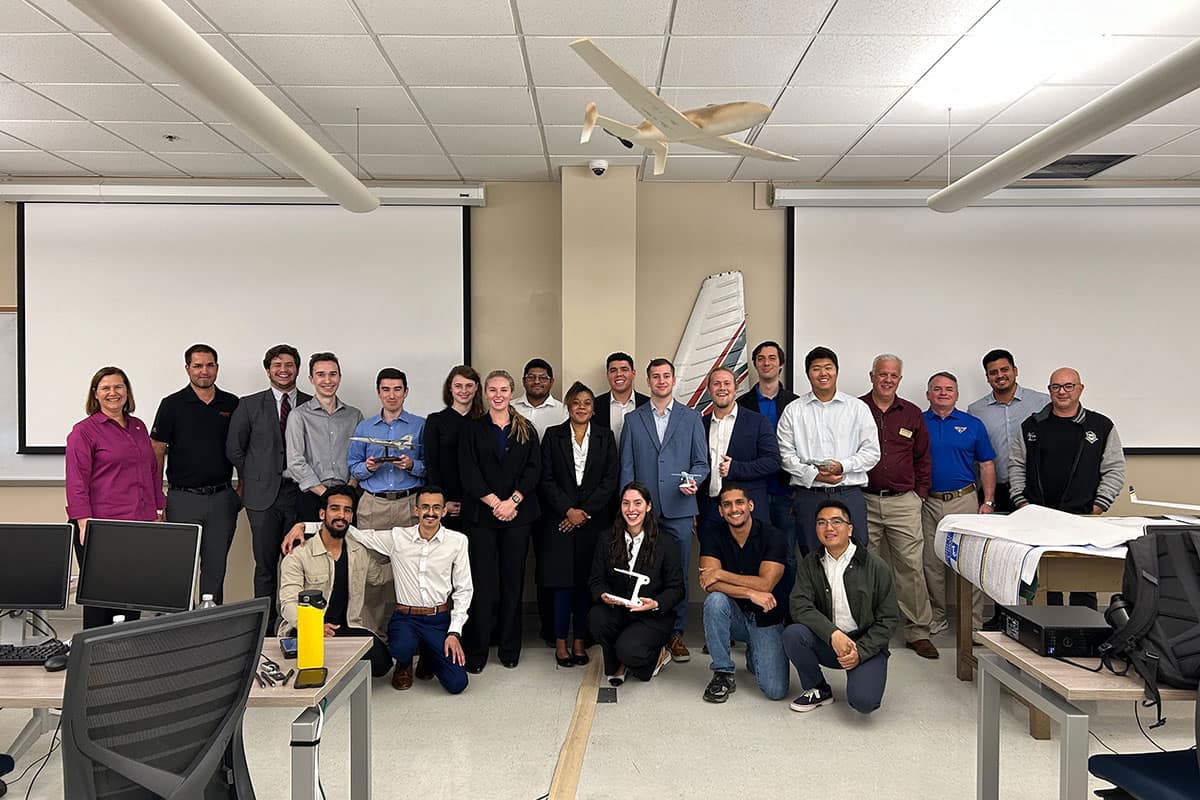Aerospace Engineering Seniors Present Final Projects to Industry Representatives

Four groups of senior Aerospace Engineering students recently presented their final capstone design projects to industry representatives from Piper Aircraft, Embraer and Northrop Grumman.
“The topics of the capstone design projects are carefully selected to be relevant and forward-thinking, demonstrating a strong understanding of current industry trends,” said Dr. Alberto Mello, associate professor of Aerospace Engineering. “Our students are expected to display not only creativity but also the practical knowledge necessary to succeed in the real world, highlighting their readiness to tackle the challenges they will encounter in their careers.”
Team Alpha’s Seahog project proposed modifications and upgrades to the A-10 Thunderbolt II for improved aircraft carrier operations. The team worked on enhancing the landing gear system and designed a fully operational tail hook to enable carrier landing capabilities.
Team Avalanche, Inc. designed a light sport aircraft capable of withstanding 6G forces and with ballistic recovery capability. The team’s design focused on the shear wing box and the attachment of the wings to the fuselage.
Team Tyche Aeronautics developed a new aircraft, named Glaive, with the capabilities of the F-15 and the size of the F-16. The team focused on the structural design of the wing. The new aircraft has a maximum takeoff weight of 48,640 pounds, a range of up to 1,740 nautical miles and the ability to sustain 10G in a symmetric maneuver.
Team Horizon Hawk proposed a modification to the Navion aircraft to accommodate larger fuel tanks in the wings for extended flight durations during aerial traffic enforcement operations. The final specifications for the modified Navion included a range of 1,300 nautical miles, an endurance of up to 8.75 hours and a maximum takeoff weight of 3,150 pounds.
“I am highly impressed by the quality of the senior design projects and presentations,” said Gustavo Peres, chief engineer and head of the Project Management Office at the Embraer Engineering and Technology Center in Melbourne, Florida. “The projects successfully integrated theoretical concepts with real-world design challenges across various subjects.”
All teams presented detailed analyses and presented the specifics of component sizing and analysis. The students also defined the expected service life of the aircraft's structure plus outlined inspection methods and intervals to ensure its structural integrity throughout its operational lifespan. Given that the aerospace industry is one of the most highly regulated sectors in the world, students must not only grasp the fundamentals and intricacies of structural design, said Mello, but also demonstrate a thorough understanding of the standards and regulations critical for ensuring airworthiness and obtaining product certification.
“I was impressed with the amount of detail covered, especially regarding the emphasis on both general structural layout and detail design of critical parts,” said Richard Dudney, structural analysis and lead engineer at Piper Aircraft. “The exposure to detail design iterations based on analytical feedback, in this case, fatigue via damage tolerance, will translate well to real-world engineering programs.”
Besides Peres and Dudney, other guests attending the final presentations included: Jorge Arroyo, Embraer engineering manager; Alex Lopazan, Northrop Grumman principal airworthiness engineer; Capt. Ed Sheppard, former U.S. Coast Guard commanding officer, engineer, aviator and maintenance officer; Kim Heinzer, associate professor of Aerospace Engineering; and Dr. Anouck Girard, Arthur F. Thurnau Professor and professor of Robotics and Aerospace Engineering at the University of Michigan.
Students on the four teams, who graduated from Embry-Riddle on Dec. 12, include: Jessie Abinsay; Raed Alalmai; Hassan Alsmery; Gabriel Ambroise; Antonio Burkhart; Francisco Bustamante; Caitlyn Garvey; Jack George; Khalfan Hableel; Spencer Kivlehan; Benjamin Liu; Midhun Mani Thomas; Joan Odorisio; Valentina Oliveira; Ian Small; and Josephine Twite.

 Melanie Stawicki Azam
Melanie Stawicki Azam